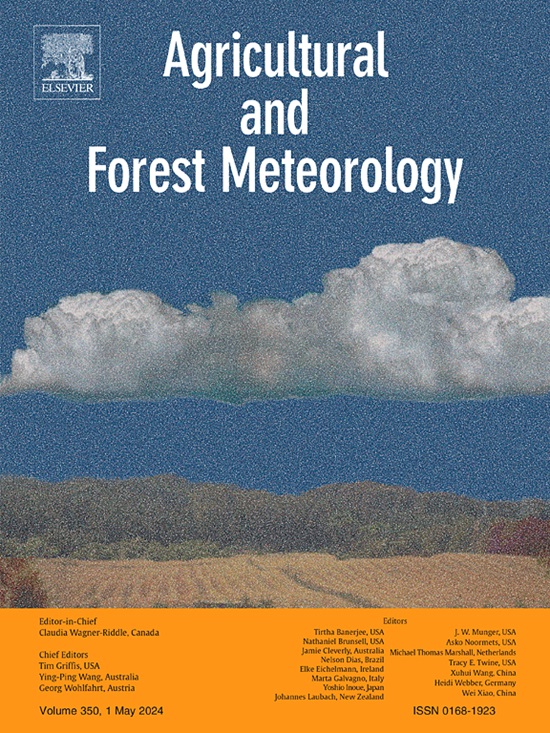Extreme droughts decrease the growth and resilience of Juniperus rigida in the northern edge but not in the southern
IF 5.6
1区 农林科学
Q1 AGRONOMY
引用次数: 0
Abstract
Impending climate change is anticipated to exacerbate the frequency and severity of extreme droughts, significantly affecting tree growth and distribution ranges. A critical endeavor in predicting how tree species will respond to more frequent and intense severe droughts is assessing the drought sensitivity and resilience of tree growth across a species' different range. However, the variation in tree growth resistance and resilience to extreme droughts across different distribution range edges have received little attention. In this study, we analyzed tree ring width data from 596 trees across 19 sites, encompassing the northernmost and southernmost distribution limits of Juniperus rigida in China. Our objectives were to delineate patterns of growth resistance, recovery and resilience to extreme droughts between northern and southern populations, and to assess their driving factors. Our findings revealed that the drought events significantly reduced the tree growth. Specifically, the tree growth has exhibited a decreasing trend in the northern distribution range limit, but an increasing trend at southern range limit since 1996, due to the more frequent and severe droughts in the northern region than in the southern. Furthermore, although the tree growth resistance and resilience were significantly higher in the northern limits than those in the southern, more frequent droughts will reduce their resistance and resilience. In addition, the growth resistance and resilience were also affected by factors such as tree age, pre-drought growth (e.g. mean growth rate and variability), and the interaction between drought characteristics and pre-drought growth. We conclude that J. rigida trees exhibit greater resistance and resilience to drought at their northern range limits compared to their southern counterparts. However, the increasing frequency and severity of droughts in the northern expose these trees to more persistent drought conditions, which could ultimately result in a decline in resilience and growth.
极端干旱会降低北部边缘刚木的生长和恢复力,而南部则不会
预计即将到来的气候变化将加剧极端干旱的频率和严重程度,严重影响树木的生长和分布范围。预测树种将如何应对更频繁、更强烈的严重干旱的一个关键努力是评估不同物种范围内树木生长的干旱敏感性和恢复力。然而,不同分布范围边缘的树木生长抗旱性和抗旱性的变化却很少受到关注。在这项研究中,我们分析了19个地点596棵树的年轮宽度数据,涵盖了中国刺柏最北和最南的分布界限。我们的目标是描述北方和南方人口对极端干旱的生长抵抗、恢复和恢复能力的模式,并评估其驱动因素。我们的研究结果表明,干旱事件显著降低了树木的生长。1996年以来,由于北方干旱比南方更频繁、更严重,树木生长在北部分布极限上呈下降趋势,而在南部分布极限上呈上升趋势。此外,尽管北部极限树木的生长抗逆性和恢复力明显高于南部极限树木,但频繁的干旱会降低其抗逆性和恢复力。此外,树龄、干旱前生长(如平均生长率和变率)以及干旱特征与干旱前生长之间的相互作用等因素也对生长抗性和恢复力产生影响。我们得出的结论是,与南方同行相比,硬叶松在其北部范围范围内表现出更强的抗旱性和抗旱性。然而,北方日益频繁和严重的干旱使这些树木面临更持久的干旱条件,这最终可能导致其恢复力和生长能力下降。
本文章由计算机程序翻译,如有差异,请以英文原文为准。
求助全文
约1分钟内获得全文
求助全文
来源期刊
CiteScore
10.30
自引率
9.70%
发文量
415
审稿时长
69 days
期刊介绍:
Agricultural and Forest Meteorology is an international journal for the publication of original articles and reviews on the inter-relationship between meteorology, agriculture, forestry, and natural ecosystems. Emphasis is on basic and applied scientific research relevant to practical problems in the field of plant and soil sciences, ecology and biogeochemistry as affected by weather as well as climate variability and change. Theoretical models should be tested against experimental data. Articles must appeal to an international audience. Special issues devoted to single topics are also published.
Typical topics include canopy micrometeorology (e.g. canopy radiation transfer, turbulence near the ground, evapotranspiration, energy balance, fluxes of trace gases), micrometeorological instrumentation (e.g., sensors for trace gases, flux measurement instruments, radiation measurement techniques), aerobiology (e.g. the dispersion of pollen, spores, insects and pesticides), biometeorology (e.g. the effect of weather and climate on plant distribution, crop yield, water-use efficiency, and plant phenology), forest-fire/weather interactions, and feedbacks from vegetation to weather and the climate system.

 求助内容:
求助内容: 应助结果提醒方式:
应助结果提醒方式:


